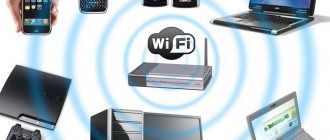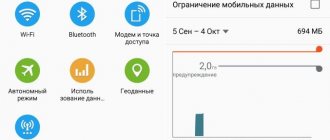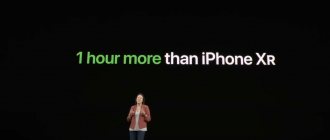Sergey Efimov
October 18, 2021
Comments (0)
Correctly configured equipment takes the user to the global web automatically, without any apparent difficulties. However, under certain unfavorable conditions, the quality of communication becomes worse. In this situation, the home Internet owner has to study the possible causes of malfunctions and understand the deep technical nuances.
Wi-Fi is a less reliable conductor than cable Internet
Wi-Fi is unstable
There may be 2 types of problems why Wi-Fi does not work well: external and internal. The first are related to the environmental conditions of the router installation, the second are related to the settings of equipment and electronic devices connected to the network.
Why does this happen even with a good signal?
The following reasons for poor wireless Internet performance are common:
- Going beyond the operating range of the equipment. A large distance between the electronic device and the connection source can cause Wi-Fi interruptions.
- Various kinds of obstacles in an apartment (thick walls or ceilings) can reflect and absorb a radio pulse, making its flow unstable.
- Problems with the provider's line. This may be due to the characteristics of the area where the house itself is located.
- Gadgets connected to 1 Wi-Fi source overload the dedicated channel.
- Low speed user plan. A bad signal may also be due to the specifics of the Internet service provider.
- Simultaneous operation of multiple programs on a laptop. They are periodically updated and require confirmation of data via Internet access.
- A low-power computer or firewall/antivirus is limiting the speed.
- Filters are set by default - for speed or the number of connected users.
- Availability of traffic restrictions.
The Internet package may have a certain limit. If the user has used all the megabytes in a day (month), Wi-Fi throughput will drop sharply, although access to web resources may remain.
In bad weather, loss or decrease in network signal level is a common occurrence.
Low Internet speed via Wi-Fi
When switching the Internet cable to wireless equipment, the speed capabilities are significantly reduced. Even if the tariff promises an excellent parameter of 100 Mbit/s, in practice it will be 1.5-2 times less. Similarly, a speed of 50 Mbps turns into 20. When the Internet owner switches back to a wired connection, the bandwidth returns to its original level.
The fact is that the Wi-Fi specifications indicate the maximum capabilities of the device - its theoretical speed, which can only be maintained in a vacuum. In real conditions, due to the presence of switches, a lot of external noise in the room and a large number of connected users, such a strong signal is unlikely.
Other reasons
Often, after updating the firmware or resetting the software, the IMEI of smartphones disappears.
Roughly speaking, IMEI is a device identifier. It's like people having a passport. Or as the MAC address of computers or other network devices.
The original IMEI code is indicated on the smartphone box.
Without IMEI, the phone will not be able to register on the network. To check the IMEI, go to the smartphone settings with information about the model of your smartphone. Or you can simply dial the code *#06# where the IMEI code and IMEI2 information will be displayed.
If the IMEI code is not displayed after the command is entered, it will have to be restored so that the smartphone can register on the network. More about Huawei: How honor is translated from Chinese. How is Huawei translated into Russian? How to pronounce Huawei correctly
What causes slow internet?
If Wi-Fi lags, this results in very unpleasant moments for the user: long loading times for websites, errors when opening popular networks, freezing of images, inability to watch online movies or download files, etc.
Checking actual Internet speed
Before calling your ISP and complaining about poor Wi-Fi internet speed, you need to do a quick check.
On a laptop you can do this via:
- Windows main menu control panel: find Network connections and open Wi-Fi status.
- Command line on the desktop. The speed is displayed in the window after the entered instructions: cmd, then - ping_site address. OK.
- Internet. Speedtest.net or Yandex.Internetometer servers will be useful here.
- Additional utilities - Networx, BWMeter, SpeedTest Desktop, JDast, etc.
When assessing bandwidth, it is advisable to minimize running programs and disable Internet access to other devices.
Often a simple reboot of the device will help restore good communication.
How to speed up Wi-Fi
Increasing speed on a laptop can be done in several ways:
- Place the router in the optimal location, directly in the room where the users are.
- Set up another channel - less busy. More about this below.
- Change the connection protocol with the access point: high-speed WAN-LAN routing only works when you select the DHCP or Static IP option.
- Buy a modem operating at a frequency of 5 Ghz or a network card that supports the IEEE 802.11n standard.
You can get a high-quality connection on your smartphone using a number of other manipulations, for example:
- Turn off 4g, activate the younger generation connection - it will not be overloaded and will give you the opportunity to access the Internet.
- Use a backup network, that is, try using a SIM card from another provider.
- Enable page compression mode in your browser.
- Delete program cache.
- Quit additional applications that have access to the World Wide Web, etc.
Internet speed on a smartphone can be increased using different methods.
How to distribute unlimited internet
Unlimited Internet with Wi-Fi distribution has many advantages. Using this function allows you to evenly distribute traffic to several mobile or desktop devices. But not everyone knows how to bypass Internet distribution restrictions. To do this, the user needs:
- Go to the “Settings” menu of your smartphone.
- Find the items “Modem” and “Access Point”.
- Find the switch that activates modem mode.
- Place this switch in the "On" position.
After this, the mobile device will be able to play the role of a router, allowing access to the services of a specific Internet provider from other devices.
Note! It will be possible to distribute traffic only to those devices that support the Wi-Fi service, and only if the Wi-Fi module is currently turned on.
Before performing the operation, you need to make sure that you have mobile traffic on your phone. If the mobile traffic provided by the operator is close to zero, this manipulation will not work. In this case, to successfully complete the operation, you need to top up your phone balance and complete all steps to receive a new mobile traffic package. The specific algorithm of actions depends on the rules established by the cellular operator. In some cases, a new traffic package is provided automatically immediately after replenishing your cell phone account balance.
Incorrect installation of the router as the cause of the malfunction
Before asking yourself whether the router can slow down the Internet, you should check the physical condition of the equipment. Then you need to evaluate the correct connection of all wires: power adapter, Internet cable and the main device for accessing the Internet.
The power button must be pressed and the corresponding indicators must be constantly lit in green. Only after this the connection occurs on the gadgets.
The overall performance of the modem is of great importance for good communication, which means:
- RAM sizes.
- Processor operating frequency.
- Built-in switch version.
- Radio module standard.
- Specific firmware.
Constant failures and delays in connection may indicate a damaged Internet cable
After the actual check, it is useful to examine the status of the network drivers. They may be outdated, which may cause the internet to freeze or not work at all.
Stages of work:
- Open Windows Settings, go to Networks and Adapter Settings.
- Click on the current Wireless connection and open Properties. Look at the Driver tab: an exclamation mark next to it indicates a malfunction.
- You need to download another utility from the official website of this network card model.
- Install software. Restart your computer and connect to Wi-Fi again.
If the actions taken do not lead to results, you should move on to deeper settings of the router - changing addresses, switching channels, changing the installed protocol, etc.
It is believed that the firmware in the equipment needs to be updated after purchase. The new software will allow you to optimize, stabilize activities, and increase the speed of WAN-LAN routing.
Setting up IP and DNS addresses
Procedure for checking the Internet protocol:
- Go through the Control Panel to Network Connections. View the status of your wireless line.
- Right-click Details. The Gateway section contains the source IP addresses of the router and DNS server. Enter for dns No. 2 - 8.8.8.8.
- Open the IPv4 Address section, go to Properties. Write the current router address for the Default Gateway and Preferred DNS.
- If the IP address of the router subnet is not specified, also enter the required characters. OK.
TCP/IP connection settings
To fix problems with Wi-Fi, you need to find the TCP IP protocol (4):
- Press Win + R at the same time.
- In the window that appears, enter the command: ncpa.cpl. OK.
- Open Wireless Connection Properties.
- Check the box next to IP version 4. OK.
- Reconnect to the Internet.
If messages like Failure or Refused occur, you should:
- Open the editor, write: regedit.
- Find the section HKEY_LOCAL_MACHINE\ SYSTEM\ CurrentControlSet\ Control\ Nsi\ {eb004a00-9b1a-11d4-9123-0050047759bc}\ 26. Right-click the mouse or touchpad of the laptop.
- Select Permissions.
- Repeat the command. Reboot the device.
Problems may appear after disassembling or repairing the router
Other problems
Here I will show other possible problems that affected the lack of Internet when connected to Wi-Fi. I won’t show you in detail, check it yourself.
- An incorrect date - often because of it, certificates, antiviruses and some other software crash, and then there is no access via the Internet to their resources, and nothing is loaded. Just look at the date so that there is no Stone Age there.
- Proxy servers, VPN – did you install anything like that? Otherwise, when people start to bypass Roskomnadzor’s blockages, then nothing works for them themselves.
- Is the Wi-Fi signal really normal? Is the problem repeating near the router? It happens that the adapter is constantly reconnected far from the access point, and as a result there is a periodic lack of Internet.
- Antiviruses - just disable it for a while. Nothing changed? It happens that everything starts to block.
And there is also a cool thing - “Problem Diagnostics”. You open it, and it will show you at what stage the problem arose and why the Internet is unavailable. Launched from the same tray:
For an Android smartphone there is a video on the same processes, but fully adapted for them:
If you find something different, write about it in the comments. And if something fits, be sure to mark it too. It’s a pleasure for us and for the readers as well. See you soon (pah-pah-pah), and may your Wi-Fi work more reliably than a Kalashnikov assault rifle. Your WiFiGid Nerd.
Because of which the frequency range may be overloaded
A Wi-Fi pulse is an electrical wave with 2 main characteristics - length and frequency. In Russia, Internet access equipment can operate in the 2.4 GHz and 5 GHz bands. In turn, inside them there are frequency lines (or channels) of different widths. More rare intervals are 0.9, 3.6, 10, 24 GHz.
The Internet provider allocates each subscriber a certain bandwidth according to the selected tariff. The scope, stability and speed capabilities of the Internet depend on it.
It is worth considering that Wi-Fi is a half-duplex connection, so in fact the router can only work effectively with 1 network client.
But even within one home line there can be a large number of users using several gadgets, which leads to serious network congestion and, consequently, problems with Wi-Fi quality.
The more clients are connected to one distribution device, the lower the speed of each device. In a situation where a certain frequency range is highly congested, you can try switching to another one.
How to change frequency and channel
Older router models only support the 2.4 GHz frequency. Within it, you can choose a width of either 20 or 40 MHz. The first will be relevant if the Internet is in an apartment building, the second - in a private room, with a weak signal.
Selecting a frequency using the example of a TP-Link modem:
- Launch the browser. In the address line indicate: 192.168.1.1 (or 0.1).
- Go to settings. Write Admin in the username and password fields.
- In the menu on the left, open Wireless mode, settings.
- Click Bandwidt and select 20 or 40.
- Save. Reboot the router.
If the router is of a modern type, similarly in its settings you can select the 5 GHz band, which can operate at a width of 80 MHz. Often, the user leaves the function of automatic selection of this parameter, and the equipment independently adjusts the frequency to external conditions.
In another way, if the router distributes Wi-Fi poorly, what to do is change the channel. This is also done through the administrator settings in the browser, the desired item is channel. It is recommended to prefer 1 of the free and non-overlapping numbers for good work. Usually this is No. 1, 6, 11.
The load on the Wi-Fi channel can be checked with the InSSider program. It displays a list of visible networks: SSID - network name, RSSI - signal strength.
An additional external antenna can act as an amplifier and stabilize the wireless Internet pulse
Troubleshooting OS problems
What are the differences between 3G and 4G networks: features, advantages and disadvantages
Sometimes the reason why the phone does not distribute Wi-Fi to the laptop is due to the fact that there are general problems in the operating system. This situation, for example, is possible in cases where a virus infection has occurred and system programs cannot operate normally.
Important! In some cases, an antivirus program can correct the consequences of its destructive effects, but this does not happen in all cases.
To eliminate them, you need to do the following:
- Reset the operating system to factory settings. Before this, you need to transfer all necessary information to other media.
- If you regularly perform the synchronization procedure using Google, then you don’t have to worry about this - the data is completely safe. However, you must take care of the safety of your documents, videos and other information yourself.
Updating the OS to the latest version may help:
- In the settings you need to go to the “Backup and reset” section. To complete this procedure, you must follow the on-screen prompts.
- Next, go to the options and start the system update.
After this, access to the World Wide Web should work at the same speed. If this does not happen, you need to update the firmware on your smartphone. Although you can do this yourself, it is recommended to take the help of professionals. This procedure is available not only on Android, but also on iPhone.
However, this option has significant disadvantages:
- The phone is connected to the computer.
- Connections organized this way are often slow.
It is possible to distribute using Bluetooth. Why you should do this depends on the availability of the appropriate devices. To enable this option, in the wireless settings (Additional functions), find the line “Bluetooth modem” and activate this feature. Only devices that have the required adapter can access such a network.
What to do if the Internet disappears on only one device
In the case where there is a loss of connection on a particular gadget, this is a sure indicator of problems regarding the settings of this device. In particular, Wi-Fi may not work well on a cell phone because:
- The network parameters are set incorrectly.
- The phone version does not match the router model.
- The region does not support this operator.
- The system memory of the smartphone is full.
- Phone overload due to various background applications.
- Internet traffic has ended.
- The browser installed is too heavy.
- The user communicates in popular social messengers; they are often overloaded, which leads to slowdown of the Internet.
The smartphone may slow down on its own due to full memory, overloaded with browser tabs.
What to do?
- Study the terms of your tariff plan in detail! It is very important to find out whether the operator really limits the distribution of traffic from the phone, and for this reason the Internet does not work on the computer (but it works on the phone!), or whether the reason is something else.
- Pay for the opportunity to distribute the Internet to other devices (if there is such an opportunity under the terms of the tariff plan).
- If possible, connect to cable internet, choose and purchase a modern Wi-Fi router and don’t bother your smartphone.
- Look for a way to bypass the blocking. Moreover, you can try to do this both on an Android phone and on an iPhone. But I do not support this and do not recommend doing this! In addition, these are some complex settings, something constantly crashes, doesn’t work, etc.
Hardware faults, can they be fixed?
When the router does not provide Wi-Fi, but the Internet is available, you need to pay attention to the actual connection. In particular, important indicators on the modem: power and wireless network. If the first one does not light, the cable may be broken somewhere or the power supply itself may have burned out. In turn, a non-working Wi-Fi icon can indicate several problems at once:
- The sharing button is disabled - the simplest option when the user can access the Internet through a router over a wire. It can be enabled on the device or activated through the browser.
- There is a problem with the router software. A reboot helps here, as does a factory reset.
- Breakdown in the distribution system. Specialist consultation is required.
In a difficult case, you may need to re-flash the Wi-Fi module.
Resetting current settings
Using Windows 10 as an example:
- Open Basic computer settings.
- Select the Network and Internet section and go to Status.
- Click on the Reset network sign. Confirm - Reset now.
- Restart the device. When enabled, allow Discover a computer on the network. OK.
No signal from Wi-Fi router
Before you begin to find out the reasons why there is no signal from the Wi-Fi router, you need to reset all settings to factory settings. There is a small button on the back of the device that must be pressed for ten to fifteen seconds. Then you can move on to the modem settings, where the main goal is the WAN point, which is responsible for connecting to the network. If the operator works with Dynamic IP, then all settings must correspond to this picture:
If your Internet provider uses a different type of connection, then you should select the appropriate option, for example Static, like the Rostelecom provider, L2TP2/Russian L2TP or others.
If the user does not know what type of connection he has, then this question can easily be answered by calling the contact center of his provider.
For example, this is what the L2TP2/Russian L2TP connection settings look like:
The router has stopped distributing Wi-Fi, but there is Internet via cable
The first step if you lose the Wi-Fi signal is to carry out a physical check of the electronics - the connection of the wires and their integrity, as well as indicator indicators.
The radio module (antenna icon) must be turned on and illuminated with a constant green light. By chance, the button may be turned off, so there is cable Internet, but the router does not distribute Wi-Fi. If there is no key on the modem body, the signal is triggered through the internal interface:
- Open any browser.
- Enter the address in the top line: 192.168.1.1.
- A menu will open. To make changes to it, you need to log in as an administrator: using the Admin username and password.
- Go to the Network Settings tab, then Wireless Mode.
- Click Turn on wireless connection. Save.
Flashing or red/orange indicators on the router indicate connection problems.
Then you need to study the status of the wireless connection and carry out detailed installation of the main parameters of the router and laptop, in particular:
- Adapter activity.
- Status of drivers and network card.
- Connection parameters: TCP/IP, IP and DNS addresses, FIPS standard, etc.
- Updating laptop or smartphone software.
- The operation of background programs that block the connection (for example, an antivirus).
The network can be disabled using hotkeys on the keyboard.
For the latest versions of Windows, the Fn function button has been added: it should be pressed in combination with other keyboard keys F1-F12. If the equipment is inoperative, it would be a good idea to check whether the modem is turned on in principle. The Fn + F1-12 combination will launch Wi-Fi - the adapter indicator will light up if the hardware is working and the drivers are active.
How do operators limit the distribution of Internet traffic?
Previously, it was mainly determined by TTL. When we distribute the Internet to another device from an Android smartphone or iPhone, the traffic packet that passes through the smartphone changes to 1. This is how the operator determines the prohibited action and takes certain measures: blocking the traffic, or charging an additional fee.
And judging by how many people (with customized bypass schemes) recently (around March 2022) had Internet distribution stop working, then at least MTS (at the moment) has seriously improved its technologies to identify “violators.”
More about Huawei: Wi-Fi priority for Android











